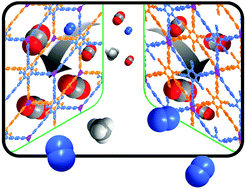Two two-dimensional (2D) microporous metal–organic frameworks, [Zn2(TMTA)(DMF)2]·NO3·2H2O·3DMF (1, DMF = N,N-dimethylformamide) and [Zn3(TETA)2(DMF)4]·3DMF (2), were synthesized via a solvothermal reaction, where H3TMTA and H3TETA are 4,4′,4′′-(2,4,6-trimethylbenzene-1,3,5-triyl)tribenzoic acid and 4,4′,4′′-(2,4,6-triethylbenzene-1,3,5-triyl)tribenzoic acid, respectively. Crystallographic studies, including powder and single crystal X-ray diffraction (XRD) analyses, reveal that compound 1 features a 2D microporous framework composed of paddle-wheel Zn2(RCOO)3 clusters and TMTA3− ligands, while the 2D double-layered structure 2 is assembled by discrete trinuclear Zn3(RCOO)6 clusters and TETA3− ligands. Both activated frameworks of 1 and 2 show permanent porosities with Brunauer–Emmett–Teller (BET) surface areas of 788 and 421 m2 g−1, respectively. Desolvated 1 exhibits a considerable carbon dioxide adsorption of 94.2 cm3 g−1 at 1 bar and 273 K, which is higher than that of 42.0 cm3 g−1 for 2. Furthermore, both materials show selective carbon dioxide adsorption over methane and nitrogen at ambient temperature.
